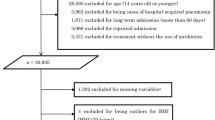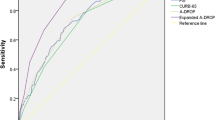Abstract
Introduction
A high proportion of patients with low-risk community-acquired pneumonia (CAP) (classes I-III of the Pneumonia Severity Index) are hospitalized. The purpose of this study was to determine whether validated severity scales are used in clinical practice to make admission decisions, identify the variables that influence this decision, and evaluate the potential predictive value of these variables.
Materials and methods
A prospective, observational study of patients ≥ 18 years of age with a diagnosis of low-risk CAP hospitalized or referred from the Emergency Department to outpatient consultations. A multivariate logistic regression predictive model was built to predict the decision to hospitalize a patient.
Results
The study population was composed of 1,208 patients (806 inpatients and 402 outpatients). The severity of CAP was estimated in 250 patients (20.7%). The factors that determined hospitalization were “abnormal findings in complementary studies” (643/806: 79.8%; due to respiratory failure in 443 patients) and “signs of clinical deterioration” [64/806 (7.9%): hypotension (16/64, 25%); hemoptoic expectoration (12/64, 18.8%); tachypnea (10/64, 15.6%)]. In total, ambulatory management was not contraindicated in 24.7% of hospitalized patients (199). The predictive model built to decide about hospitalization had a good power of discrimination (AUC 0.876; 95%CI: 0.855–0.897).
Conclusions
Scales are rarely used to estimate the severity of CAP at the emergency department. The decision to hospitalize or not a patient largely depends on the clinical experience of the physician. Our predictive model showed a good power to discriminate the patients who required hospitalization. Further studies are warranted to validate these results.


Similar content being viewed by others
Data availability
Data available on request fro the authors.
References
WHO. The top 10 causes of death [Internet]. WHO. [Citado el 19 de julio de 2017.] Disponible en: http://www.who.int/mediacentre/factsheets/fs310/en/
GBD (2015) Mortality and Causes of Death Collaborators. Global, regional, and national life expectancy, all-cause mortality, and cause-specific mortality for 249 causes of death, 1980–2015: a systematic analysis for the Global Burden of Disease Study 2015. Lancet Lond Engl 388:1459–544
Welte T, Torres A, Nathwani D (2012) Clinical and economic burden of community-acquired pneumonia among adults in Europe. Thorax 67:71–79
Sato R, Gomez Rey G, Nelson S et al (2013) Community-acquired pneumonia episode costs by age and risk in commercially insured US adults aged ≥50 years. Appl Health Econ Health Policy 11:251–258
Fine MJ, Auble TE, Yealy DM et al (1997) A prediction rule to identify low-risk patients with community-acquired pneumonia. N Engl J Med 336:243–250
Lim WS, van der Eerden MM, Laing R et al (2003) Defining community acquired pneumonia severity on presentation to hospital: An international derivation and validation study. Thorax 58:377–382
Menéndez R, Cilloniz C, España PP et al (2020) Community-Acquired Pneumonia. Spanish Society of Pulmonology and Thoracic Surgery (SEPAR) Guidelines. 2020 Update. Arch Bronconeumol 56(S1):1–10
Metlay JP, Waterer GW, Long AC et al (2019) Diagnosis and treatment of adults with community-acquired pneumonia. An oficial clinical practice guideline of the American Thoracic Society and Infectious Diseases Society of America. Am J Respir Crit Care Med 200:e45-67
Jain S, Williams DJ, Arnold SR et al (2015) Community-acquired pneumonia requiring hospitalization among U.S. children. N Engl J Med 372:835–45
Marcos PJ, Restrepo MI, González-Barcala FJ et al (2018) Discordance of physician clinical judgment vs. pneumonia severity index (PSI) score to admit patients with low risk community-acquired pneumonia: a prospective multicenter study. J Thorac Dis 9:1538–46
Bartlett JG, Dowell SF, Mandell LA et al (2000) Practice guidelines for the management of community acquired pneumonia in adults. Infectious Diseases Society of America. Clin Infect Dis 31:347–82
Niederman MS, Mandell LA, Anzueto A et al (2001) Guidelines for the management of adults with community-acquired pneumonia: American Thoracic Society. Am J Respir Crit Care Med 163:1730–1754
Hoe L, Keang L (1998) Hospitalized low-risk community-acquired pneumonia: outcome and potential for cost savings. Respirology 4:307–309
Musher DM, Thorner AR (2014) Community-acquired pneumonia. N Engl J Med 371:1619–1628
Van Buuren S (2018) Flexible Imputation of Missing Data, 2nd edn. Chapman & Hall/CRC Interdisciplinary Statistics, Boca Raton
Regression HF, Strategies M (2015) With Applications to Linear Models, Logistic and Ordinal Regression, and Survival Analysis. Springer, New York
Heymans MW, van Buuren S, Knol DL, van Mechelen W, de Vet HCW (2007) Variable selection under multiple imputation using the bootstrap in a prognostic study. BMC Med Res Methodol 7:33
Steyerberg EW (2009) Clinical Prediction Models. A Practical Approach to Development, Validation, and Updating. Springer, New York. https://doi.org/10.1007/978-3-030-16399-0
López-Ratón M, Rodríguez-Álvarez MX, Cadarso-Suárez C et al (2014) Optimal cutpoints: An R package for selecting optimal cutpoints in diagnostic tests. J Statistic Software 61:1–36
Marrie TJ, Lau CY, Wheeler SL et al (2000) A controlled trial of a critical pathway for treatment of community acquired pneumonia. CAPITAL Study Investigators. JAMA 283:749–755
Carratala J, Fernandez-Sabe N, Ortega L et al (2005) Outpatient care compared with hospitalization for community-acquired pneumonia: a randomized trial in low-risk patients. Ann Intern Med 142:165–172
Labarere J, Stone RA, Obrosky DS, et al (2006) Factors associated with the hospitalization of low-risk patients with community-acquired pneumonia in a cluster-randomized trial. J Gen Intern Med 745–52
Aujesky D, McCausland JB, Whittle J et al (2009) Reasons Why Emergency Department Providers do not Rely On the Pneumonia Severity ndex to determine the initial site of treatment for patients with pneumonia. Clin Infect Dis 49:e100–e108
Halm EA, Atlas SJ, Borowsky LH et al (2000) Understanding physician adherence with a pneumonia practice guideline. Arch Intern Med 160:98–104
Rosón B, Carratalà J, Dorca J et al (2001) Etiology, reasons for hospitalization, risk classes, and outcomes of community-acquired pneumonia in patients hospitalized on the basis of conventional admission criteria. CID 33:158–165
España PP, Capelastegui A, Quintana JM et al (2003) A prediction rule to identify allocation of inpatient care in community-acquired pneumonia. Eur Respir J 21:695–701
Goss CH, Rubenfeld GD, Park DR et al (2003) Cost and incidence of social comorbidities in low-risk patients with community-acquired pneumonia admitted to a public hospital. Chest 124:2148–2155
Arnold FW, Ramirez JA, McDonald LC et al (2003) Hospitalization for Community-Acquired Pneumonia. The Pneumonia Severity Index vs Clinical Judgment. Chest 124:121–4
Marrie TJ (2004) Deaths in risk classes I-III: a measure of quality of care in patients hospitalised with CAP? Eur Respir J 23:103–105
Calbo E, Ochoa de Echagüen A, Rodríguez-Carballeira M et al (2004) Hospital admission, duration of stay and mortality in community-acquired pneumonia in an acute care hospital. Correlation between a pneumonia prognosis index and conventional clinical criteria for assessing severity. Enferm Infecc Microbiol Clin 22:64–9
Marrie TJ, Huang JQ (2005) Low-risk patients admitted with community-acquired pneumonia. Am J Med 118:1357–1363
Buising KL, Thursky KA, Black JF et al (2006) A prospective comparison of severity scores for identifying patients with severe community acquired pneumonia: reconsidering what is meant by severe pneumonia. Thorax 61:419–424
Johnstone J, Eurich DT, Majumdar SR et al (2008) Long-term morbidity and mortality after hospitalization with community-acquired pneumonia. A population-based cohort study. Medicine 87:329–334
Singanayagam A, Chalmers JD, Hill AT (2009) Admission hypoglycaemia is associated with adverse outcome in community-acquired pneumonia. Eur Respir J 34:932–939
Chang CL, Mills GD, Karalus NC et al (2013) Biomarkers of cardiac dysfunction and mortality from community-acquired pneumonia in adults. PLoS One 8:e62612
Viasus D, Garcia-Vidal C, Simonetti A et al (2013) Prognostic value of serum albumin levels in hospitalized adults with community-acquired pneumonia. J Infect 66:415–423
Li J, Ye H, Zhao L (2015) B-type natriuretic peptide in predicting the severity of community-acquired pneumonia. World J Emerg Med 6:131–136
Violi F, Cangemi R, Falcone M et al (2017) Cardiovascular Complications and Short-term Mortality Risk in Community-Acquired Pneumonia. Clin Infect Dis 64:1486–1493
Ramirez JA, Wiemken TL, Peyrani P et al (2017) Adults hospitalized with pneumonia in the United States: Incidence, epidemiology, and mortality. Clin Infect Dis 65:1806–1812
Bramley AM, Reed C, Finelli L et al (2017) Relationship Between Body mass index and outcomes among hospitalized patients with community-acquired pneumonia. J Infect Dis 215:1873–1882
Çilli A, Sayner A, Çelenk B et al (2018) Antibiotic treatment outcomes in community-acquired pneumonia. Turk J Med Sci 48:730–736
Samaniego FA, Ghelfi AM, Rodríguez MS (2019) Neumonía adquirida en la comunidad de bajo riesgo: consecuencias evolutivas de los determinantes de internación no contemplados por los scores. Semergen 45:516–522
Peyrani P, Arnold FW, Bordon J et al (2020) Incidence and mortality of adults hospitalized with community-acquired pneumonia according to clinical course. Chest 157:34–41
Alonso R, Santillán-Barletta M, Rodríguez CL et al (2021) Community acquired pneumonia in patients requiring hospitalization. Medicina (B Aires) 81:37–46
Dwyer R, Kalin M (2021) Significance of the physician’s and the patient’s sex in hospitalized patients with community-acquired pneumonia. Infect Dis (Lond) 53:538–545
Chalmers JD, Rutherford J (2012) Can we use severity assessment tolos to increase outpatient management of community-acquired pneumonia? Eur J Intern Med 23:398–406
Stauble SP, Reichlin S, Dieterle T et al (2001) Community-acquired pneumonia: which patients are hospitalised? Swiss Med Wkly 131:188–192
Restrepo MI, Mortensen EM, Pugh JA et al (2006) COPD is associated with increased mortality in patients with community-acquired pneumonia. Eur Respir J 28:346–351
Funding
None.
Author information
Authors and Affiliations
Contributions
Adriana Lama Author and drafting, Conception and design, Approval of the final manuscript, Francisco Gude Author and drafting, Conception and design, Approval of the final manuscript, María Elena Toubes Co-author, Approval of the final manuscript, Ana Casal Co-author, Approval of the final manuscript, Jorge Ricoy Co-author, Approval of the final manuscript, Carlos Rábade. Co-author. Approval of the final manuscript, Nuria Rodríguez Núñez Co-author, Approval of the final manuscript, Ana Cao-Ríos Co-author, Approval of the final manuscript, Uxío Calvo Co-autor, Approval of the final manuscript, Luis Valdés Author and drafting, Conception and design, Approval of the final manuscript.
Corresponding author
Ethics declarations
Competing interest
We declare no conflicts of interest associated with this publication. This project did not receive financial support that could have influenced its outcome.
Additional information
Publisher's Note
Springer Nature remains neutral with regard to jurisdictional claims in published maps and institutional affiliations.
Supplementary Information
Below is the link to the electronic supplementary material.
Rights and permissions
Springer Nature or its licensor (e.g. a society or other partner) holds exclusive rights to this article under a publishing agreement with the author(s) or other rightsholder(s); author self-archiving of the accepted manuscript version of this article is solely governed by the terms of such publishing agreement and applicable law.
About this article
Cite this article
Lama, A., Gude, F., Toubes, M.E. et al. Usefulness of a predictive model to hospitalize patients with low-risk community-acquired pneumonia. Eur J Clin Microbiol Infect Dis 43, 61–71 (2024). https://doi.org/10.1007/s10096-023-04683-w
Received:
Accepted:
Published:
Issue Date:
DOI: https://doi.org/10.1007/s10096-023-04683-w




